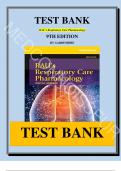TEST BANK TEST BANK RAU’s Respiratory Care Pharmacology 9TH EDITION BY GARDENHIRE MEDCONNOISSEUR Description Test Bank for Rau’s Respiratory Care Pharmacology 9th Edition Gardenhire Test Bank for Rau’s Respiratory Care Pharmacology, 9th Edition, Gardenhire, ISBN -10: 0323299 687, ISBN -13: 9780323299688 Table of Contents Unit I: Basic Concepts and Principles in Pharmacology 1. Introduction to Respiratory Care Pharmacology 2. Principles of Drug Action 3. Administration of Aerosolized Agents 4. Calculating Drug Doses 5. The Central and Peripheral Nervous Systems Unit II: Drugs Used to Treat the Respiratory System 6. Adrenergic (Sympathomimetic) Bronchodilators 7. Anticholinergic (Parasympatholytic) Bronchodilators 8. Xanthines 9. Mucus -Controlling Drug Therapy 10. Surfactant Agents 11. Corticosteriods in Respiratory Care 12. Nonsteroidal Antiasthma Agents 13. Aerosolized Antiinfective Agents 14. Antimicrobial Agents 15. Cold and Cough Agents 16. Selected Agents of Pulmonary Value 17. Neonatal and Pediatric Aerosolized Drug Therapy Unit III: Critical Care, Cardiovascular, and Polysomnography Agents 18. Skeletal Muscle Relaxants (Neuromuscular Blocking Agents) 19. Diuretic Agents 20. Drugs Affecting the Central Nervous System 21. Vasopressors, Inotropes, and Antiarrythmic Agents 22. Drugs Affecting Circulation: Antihypertensives, Antianginals, Antithrombotics 23. Sleep and Sleep Pharmacology MEDCONNOISSEUR Chapter 01: Introduction to Respiratory Care Pharmacology Gardenhire: Rau’s Respiratory Care Pharmacology, 9th Edition MULTIPLE CHOICE 1. What is the name of the receptor sites that are located in the peripheral vasculature, the heart, bronchial muscle, and bronchial blood vessels? a. Beta 2 receptors c. Alpha receptors b. Gamma receptors d. Beta 1 receptors ANS: C Alpha receptors are located in the peripheral vasculature, the heart, bronchial muscle, and bronchial blood vessels. PTS: 1 2. Which receptor site results in tachycardia, an increased potential for arrhythmias, and an increased cardiac output? a. Beta 1 receptor c. Alpha receptor b. Beta 2 receptor d. Delta receptor ANS: A Stimulation of the beta-1 receptors results in tachycardia, an increased potential for arrhythmias, and an increased cardiac output. In administering drugs to the pulmon ary system, stimulation of the beta-1 sites is not desired. However, most respiratory pharmacologic agents have some beta -1 stimulatory effect. PTS: 1 3. Stimulation of the beta 2 receptors causes a. peripheral vasoconstriction and mild bronchoconstriction in the lungs. b. tachycardia, an increased potential for arrhythmias, and an increased cardiac output. c. bronchodilation. d. peripheral vasodilation, bradycardia, and decreased cardiac output. ANS: C Stimulation of the beta-2 receptors in the lungs causes bronchod ilation. PTS: 1 4. Acetylcholine stimulates a. the Vagus nerve. b. the adrenergic receptors. c. the sympathetic nervous system. d. the cholinergic receptors. ANS: D Acetylcholine stimulates the cholinergic receptors. PTS: 1 5. What immunoglobulin antibody sensitizes the mast cell? a. Leukotrienes c. Histamine MEDCONNOISSEUR b. IgE d. Prostaglandins ANS: B The IgE (reagin) antibodies sensitize the mast cell. Repeated exposure to the antigen causes the degranulation of the mast cell. PTS: 1 6. Which of the following is caused by histamin e release from the mast cells? I. Bronchodilation II. Increased bronchial gland secretion III. Increased amount of mucus present in the airways a. I and II only c. III only b. II and III only d. I, II, III ANS: B Histamine is also a potent bronchoconstrictor. In addition to its bronchoconstrictive activity, histamine II) increases bronchial gland secretion, causing III) an increase in the amount of mucus present in the airways. Histamine may also have an effect on vascular permeability similar to the effect of - SRS-A. PTS: 1 7. A sympathomimetic drug would cause a. bronchodilation. c. Histamine release. b. bronchoconstriction. d. Vagus nerve stimulation. ANS: A A sympathomimetic drug would cause bronchodilation. Sympathomimetic agents are the drugs most commonly used to reverse bronchospasm. PTS: 1 8. Stimulation of the sympathetic nervous system causes a. vascular permeability. c. bronchodilation. b. decreased blood pressure. d. bronchoconstriction. ANS: C Sympathetic nervous system stimulation causes bronchodilation. PTS: 1 9. Whic h of the following would NOT cause a bronchospasm or bronchoconstriction? a. Leukotrienes c. Histamine b. Beta 1 receptors d. Prostaglandins ANS: B Beta -1 receptors would not cause a bronchospasm or bronchoconstriction. Leukotrienes are one of many chemical medi ators released by the mast cells. Leukotrienes cause a direct, strong bronchoconstriction. Histamine is also a potent bronchoconstrictor. Prostaglandins cause a strong bronchospasm, especially in asthmatic patients. PTS: 1 MEDCONNOISSEUR




